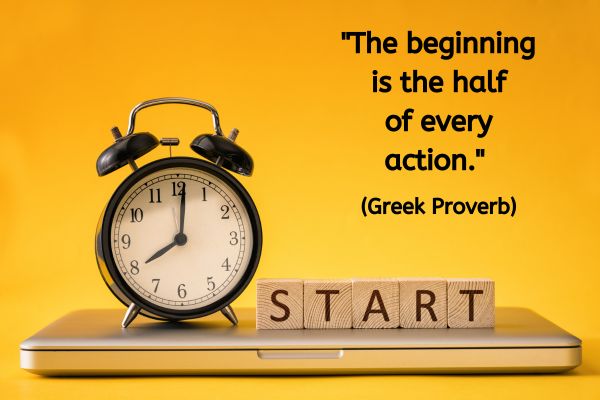The Power of Beginnings

Today’s quote to begin the week is actually a proverb:
“The beginning is the half of every action,” (Greek proverb)
In the realm of coaching, beginnings hold a unique significance. They mark the inception of transformation, the genesis of growth, and the initiation of a journey towards self-discovery. As coaches, we are entrusted with the profound responsibility of guiding our clients through the pivotal act of commencement, where aspirations converge with action.
The essence of this proverb lies not merely in its brevity, but in its profound implications for our coaching practice. It serves as a poignant reminder of the transformative power inherent in the act of initiation. For every action undertaken, whether personal or professional, the journey begins with that crucial first step. It is the moment when dreams are crystallized into tangible goals, and intentions are transmuted into action plans or identifying what the next step will be.
As coaches, we are often confronted with clients who stand at the precipice of change, teetering on the brink of uncertainty and possibility. In these moments, our role transcends that of mere facilitators; we become catalysts for transformation, guiding our clients through the labyrinth of self-discovery and empowerment. The proverb challenges us to embrace the potency of beginnings, to recognize that the seeds of greatness are sown in the fertile soil of new beginnings.
I suspect that there will be an element of your own personal coaching style and a sense of what each individual client will respond to when it comes to how you encourage a client to start. If a client appears to be struggling taking a first step, two things often occur to me – 1) Is this actually something they want? 2) What’s stopping them? – Are they just overwhelming themselves with thinking they need to have the whole plan decided upon rather than just a first step (notice a first step, not the first step)
At the heart of most coaching journeys lies the willingness to confront the unknown, to venture into uncharted territories. It is here, in the crucible of uncertainty, that true growth and transformation occur. As coaches, we must inspire our clients to embrace any inherent discomfort of beginnings, to see it not as a barrier but as a gateway to new possibilities.
When I read the proverb one of the first questions I pondered was if that’s half of every action what goes into the other half? The answer I came up with is that there can be variables at play, willingness, determination, resilience, consistency and momentum were all aspects that occured to me – what else would you add into that mix?
It also occured to me that beginning does not have to be about starting a brand new project, it can be about the approach to a next stage of an existing project or even bringing a new approach to an existing area.
The Greek proverb serves as a poignant reminder of the transformative power inherent in beginnings. It challenges us to embrace the journey with courage and conviction, to recognize that every step taken brings us closer to realizing our true potential. As coaches, let us stand at the threshold of possibility with our clients, ready to embark on a journey of growth, discovery, and transformation. So I will leave you this Monday with the question – What are you going to begin at the start of this new week? A new book? A new invitation to experience your coaching? A new personal goal? Or will it be a new approach to an existing project?
About Jen Waller

Jen Waller is on a mission to support, nurture and encourage coaching skills and talents from non-coach to coach and beyond.
As an experienced coach and trainer Jen is happy to utilise all skills at her disposal to assist clients from getting out of their own way and making a difference in the world with their coaching. Find out more about the support Jen offers here.
 Jen Waller is on a mission to support, nurture and encourage coaching skills and talents from non-coach to coach and beyond.
Jen Waller is on a mission to support, nurture and encourage coaching skills and talents from non-coach to coach and beyond.